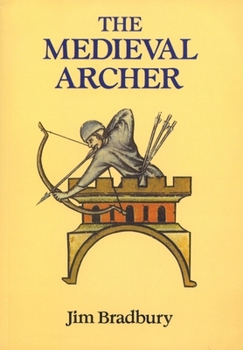The Medieval Archer
Select Format
Select Condition 
Book Overview
A study of the archer and his weapon from the 11th to the 15th century, focusing on military tactics but also exploring the archer's position in society. It is a delight to read a book which recognises the importance of warfare in medieval times...also...discusses the changing role of the archer in medieval society. SIR STEVEN RUNCIMAN This book traces the historyof the archer in the medieval period, from the Norman Conquest to the...
Format:Paperback
Language:English
ISBN:0851156754
ISBN13:9780851156750
Release Date:November 1996
Publisher:Boydell Press
Length:206 Pages
Weight:1.09 lbs.
Dimensions:0.5" x 6.7" x 9.5"
Customer Reviews
3 ratings
The Medieval Archer
Published by Thriftbooks.com User , 14 years ago
FAST shipping! Very pleased. I would buy from this seller again and again.
One of the great books on the storied history of the longbow
Published by Thriftbooks.com User , 17 years ago
I read this book for a graduate course in medieval history. Jim Bradbury is a great historian of the longbow. "The Medieval Archer" is a great comprehensive work for the history of this medieval weapon of mass destruction. In his book, Featherstone has meticulously researched the history of the longbow, from ancient history through its greatest impact in warfare during the Hundred Years' War; specifically, the battles of Crecy, Poitiers, and Agincourt. Bradbury turns his attention to the more detailed study of the longbow's genesis and development in Britain. It is definitively impossible to know when the longbow first came into existence in Britain. However, history does record several historical periods when we know that the longbow, or a weapon similar to it, was used and introduced by invaders of the British Isles. There is evidence that shows that the Germanic longbow made its way into Britain with the invasion of the Saxons in the fifth century. Viking law, from mid-tenth century, required that while aboard ship, fighting men must be equipped with bows and arrows as an addition to their other usual weapons that they employed in their raiding parties. One can still read Viking Sagas of the era extolling the use of bows and arrows as weapons. In 1055, Welsh bowmen while firing from hidden positions on mountain ridges, cut down the Earl of Hereford's Saxon cavalry with devastating effect. This action would be a great lesson lost on King Harold eleven years later, in his defeat at the battle of Hastings. King Harold did have some longbow men in the battle, if one takes the Bayeux Tapestry to be a true pictorial history of the Norman Conquest. Unfortunately, for the Anglo-Saxon army of King Harold, he had to travel very quickly over 250 miles south to engage the invading Normans, which prevented him from taking many archers on foot. In fact, the Bayeux Tapestry is famous for its depiction of King Harold being fatally shot in the eye by a Norman arrow, and thus, changing the course of British history forever. It is during the fourteenth century in Britain that the longbow gains its reputation as a force multiplier in battle. In military terminology, a force multiplier denotes a factor, in this case, the longbow providing a technological factor, dramatically increasing the combat capability of a military force. In keeping with the theme of our course in comparing fourteenth century events to modern times, one can easily equate the importance of the longbow to fourteenth century warfare in the same way that one can compare the importance that the machine gun had on early twentieth century warfare-specifically during World War I. The longbow provided the English armies of Edward I, through the end of the Hundred Years' War, a distinct and singular advantage over the French armies and their cavalry forces. Despite all of the early history of the longbow in Britain, it is Edward I who is the real progenitor of the longbow, as use
Fascinating history of a lethal weapon
Published by Thriftbooks.com User , 23 years ago
The Medieval Archer traces the use of archery in English wars, from the Battle of Hastings, in 1066, to the Wars of the Roses which ended with the death of Richard III, the last Plantagenet king, in 1485. The book has interesting details about a few English battles before the Norman Conquest and interesting details about crossbows, as well as the shortbows used on the Continent, but it really is about the English longbow, during the time it flourished.The English longbow was very lethal, very fast shooting and cheap to make, but required great skill to use. It allowed small English armies to dominate larger French armies for a long time. The wonder was that English bowmen did not use such a potent weapon to sweep away their own kings and princes, or that slow-firing, less accurate gunpowder weapons were able to displace it so quickly.Read this book and learn why.





